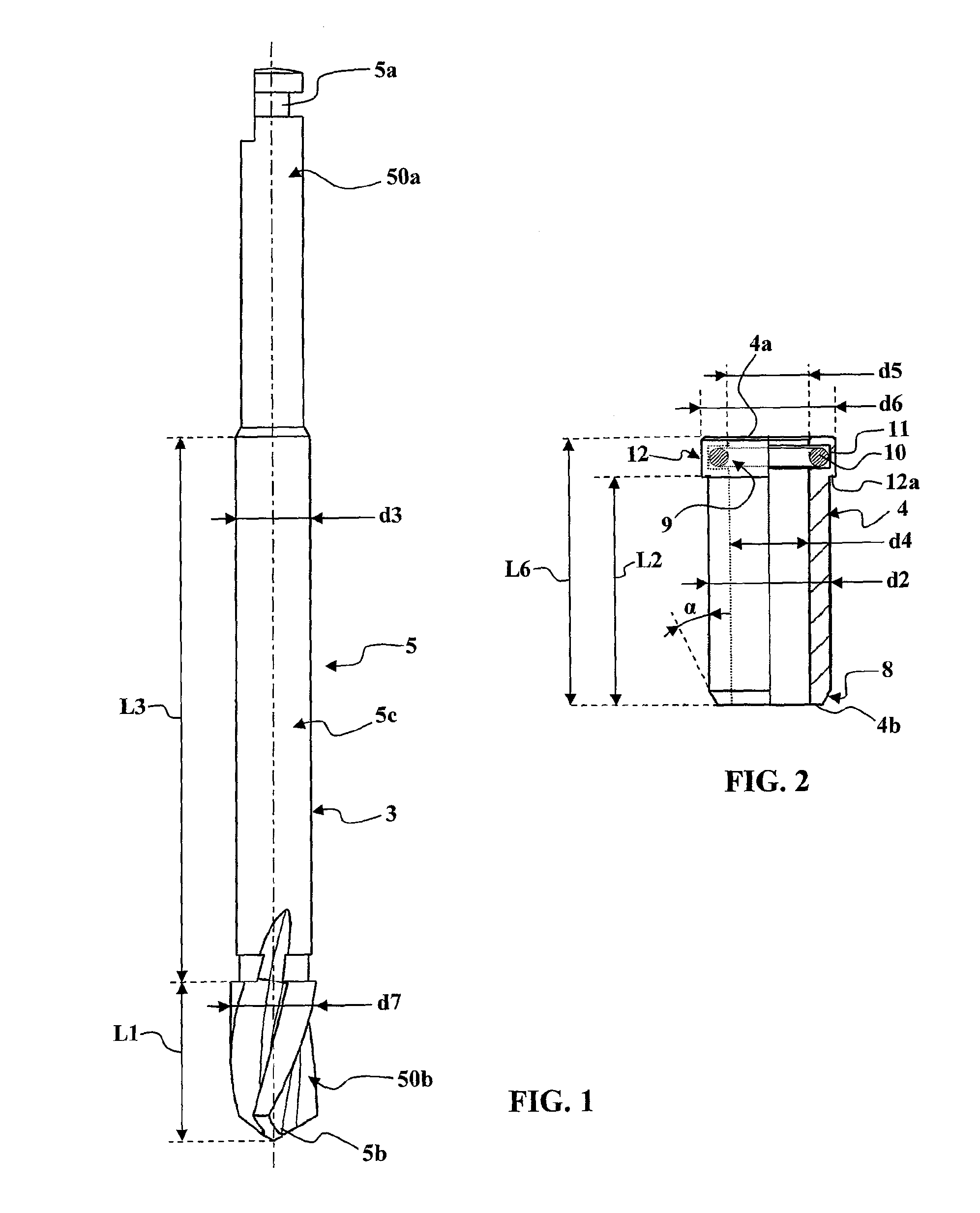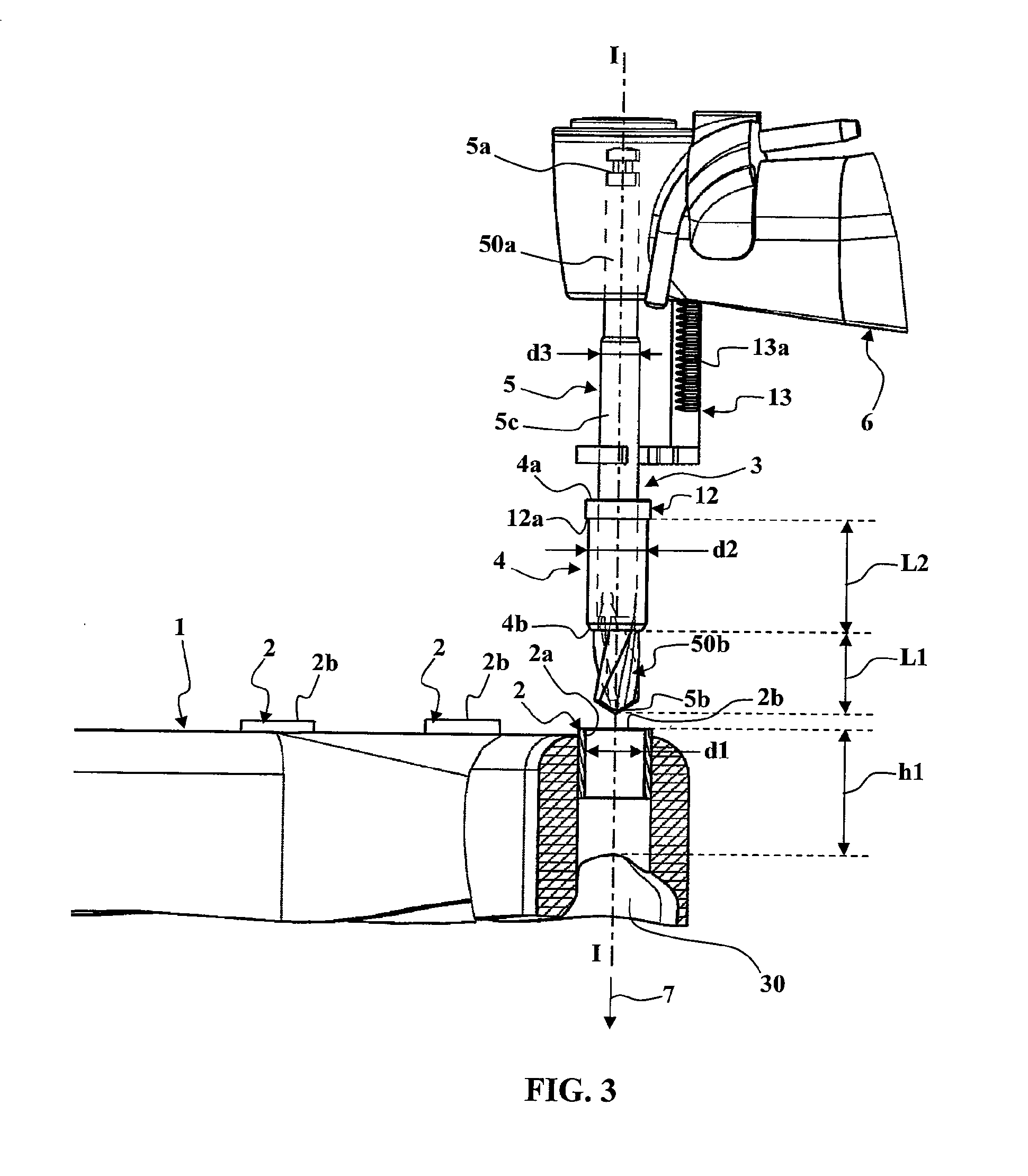Device for centering and guiding a drill bit of a dental handpiece
- Summary
- Abstract
- Description
- Claims
- Application Information
AI Technical Summary
Benefits of technology
Problems solved by technology
Method used
Image
Examples
example 1
Drilling a Hole in the Jaw of the Patient with a Device of the First Embodiment
[0119]In this example, the following choices are made:
[0120]h1 is made equal to 9 mm,
[0121]L1 is made equal to 5 mm,
[0122]L2 is made equal to 8 mm,
[0123]L3 is made equal to 30 mm,
[0124]L6 is made equal to approximately 10 mm,
[0125]d1 is made equal to 4.2 mm,
[0126]d2 is made equal to 4.17 mm,
[0127]d3 is made equal to 2.8 mm;
[0128]d4 is made equal to 2.8 mm (+clearance),
[0129]d5 is made equal to 2.8 mm (+clearance),
[0130]d6 is made equal to 4.6 mm.
[0131]The practitioner mounts the guide sleeve 4 on the intermediate section 5c with the distal end 4b abutted against the distal cutting section 50b and then fixes the drill bit 5 to the dental handpiece 6 fitted with abutment means 13. The practitioner then adjusts the height of the abutment means 13 to drill a hole of particular depth.
[0132]When the drill bit 5 comes into contact with the jawbone of the patient, the guide sleeve 4 is already engaged in the tubu...
example 2
Adjustment of the Device of the Second Embodiment to Drill a Hole 8 Mm Deep in the Jaw of the Patient
[0159]In this example, the first height h1 is 9 mm, the axial movement allowed by the spring means 15 is 15 mm and the axial length L5 of the guide sleeve 4 is 8 mm.
[0160]To adjust conveniently the axial position of the guide sleeve 4, the practitioner mounts the drill bit 5 and the centering and guiding device of the second embodiment of the invention on the dental handpiece 6.
[0161]The rack of the support rod 19 is immobilized in the receiving sleeve 20 so that, when the spring means 15 are compressed (guide sleeve 4 in high position), the proximal end 4a of the guide sleeve is at a distance from the distal end 5b of the drill bit 5 equal to the sum of the first height h1 and the required depth of the hole (8 mm in this example), that is to say 17 mm here. In the low position, the proximal end 4a of the guide sleeve 4 is therefore offset from the distal end 5b of the drill bit 5 by...
example 3
Adjustment of the Device of the Second Embodiment to Drill a Hole 15 Mm Deep in the Jaw of the Patient
[0162]In this example, the first height h1 is 9 mm, the axial movement allowed by the spring means 15 is 15 mm and the axial length L5 of the guide sleeve 4 is 8 mm.
[0163]In order to adjust conveniently the axial position of the guide sleeve 4, the practitioner mounts the drill bit 5 and the centering and guiding device of the second embodiment of the invention on the dental handpiece 6. The rack of the support rod 19 is immobilized in the receiving sleeve 20 so that, when the spring means 15 are compressed (guide sleeve 4 in high position), the proximal end 4a of the guide sleeve is at a distance from the distal end 5b of the drill bit 5 equal to the sum of the first height h1 and the required depth of the hole (15 mm in this example), i.e. 24 mm here.
[0164]In the low position, the proximal end 4a of the guide sleeve 4 is therefore offset from the distal end 5b of the drill bit 5 b...
PUM
 Login to View More
Login to View More Abstract
Description
Claims
Application Information
 Login to View More
Login to View More - R&D
- Intellectual Property
- Life Sciences
- Materials
- Tech Scout
- Unparalleled Data Quality
- Higher Quality Content
- 60% Fewer Hallucinations
Browse by: Latest US Patents, China's latest patents, Technical Efficacy Thesaurus, Application Domain, Technology Topic, Popular Technical Reports.
© 2025 PatSnap. All rights reserved.Legal|Privacy policy|Modern Slavery Act Transparency Statement|Sitemap|About US| Contact US: help@patsnap.com



